| |
 |
Archive for Professional Interest
August 4, 2011 at 12:21 pm
· Filed under General Nutrition & Wellness, Nutrition, Professional Interest, Wellness
 “Imagine that the World had created a new ‘dream product’ to feed and immunize everyone born on earth. Imagine also that it was available everywhere, required no storage or delivery and helped mothers to plan their families and reduce the risk of cancer. Then imagine that the world refused to use it”. — James Grant, Executive Director for Unicef (1980-1995). “Imagine that the World had created a new ‘dream product’ to feed and immunize everyone born on earth. Imagine also that it was available everywhere, required no storage or delivery and helped mothers to plan their families and reduce the risk of cancer. Then imagine that the world refused to use it”. — James Grant, Executive Director for Unicef (1980-1995).
John and I are huge fans of breastfeeding. As parents, we have seen the wonderful outcomes and rewards that breastfeeding has provided in our own children. As Registered Dietitians, we know that breastmilk is nature’s most perfect food. Besides the ideal balance of carbohydrate, protein, fat and micronutrients, it contains antibodies specifically obtained from the mother to destroy viruses and harmful bacteria. The benefits of breastmilk extend well into an infant’s adult years and will reduce their risk of ever developing obesity, diabetes or cancer.
This week is World Breastfeeding Week and the World Alliance for Breastfeeding Action (WABA) has announced this year’s theme as “Talk to me! Breastfeeding – a 3D Experience”. The focus is not only on the importance of the mother-baby connection (two-dimensions) but also the support needed from the health care system, friends, family members and the community (the ever-important 3rd dimension).
For more information about this year’s world breastfeeding theme, visit the WABA website at www.worldbreastfeedingweek.org. Also, to view what the state of North Carolina is doing to encourage support for nursing moms, please see: http://www.ncdhhs.gov/pressrel/2011/2011-08-01-nursing_moms.htm.
It’s Your Health. It’s Your Life. Make That Change!
~ Angie
Православни иконииконописikoni
Permalink
July 11, 2011 at 2:55 pm
· Filed under General Nutrition & Wellness, Nutrition, Professional Interest, Wellness

Enjoy Fresh, Real Food at Home with this excellent cookbook and healthy eating guide….
Chef & fellow Registered Dietitian Maggie Green put her whole heart and soul in this cookbook. Her love for her home state of Kentucky as well as her love for cooking & sharing meals with her large family shines through in this book. Maggie stresses the importance of buying local and buying seasonal. The month-by-month format of delicious recipes allows you to plan your meals according to what is fresh and in season for that particular month. We really like the calendar of menus that she has organized according to the occasion (such as the “St. Patrick’s Day” menu and the “Kentucky Derby Bash”).
Although we reside in North Carolina, we will treasure this cookbook! We have really enjoyed using our home-grown parsley for the “Lentil Soup with Red Wine and Parsley” recipe. The kids enjoy it too!
Maggie says, “Never has there been a greater call to unleash the potential of our kitchens and make them places of action, places where families cook, eat and live together, one meal at a time”. We could not agree more. When meals are cooked at home and shared together, we eat healthier and we strengthen our family bonds. Preparing and eating more meals at home is part of the solution to our country’s growing obesity and diabetes epidemic.
For more information about the book or to order a copy, you can visit: http://greenapron.com/book/.
It’s Your Health. It’s Your Life. Make That Change!!!
~ Angie & Johnикони
Permalink
May 16, 2011 at 9:19 am
· Filed under Diabetes, General Nutrition & Wellness, Nutrition, Professional Interest, Wellness
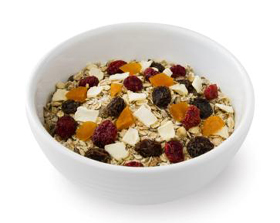
Sharing a quick and easy summer breakfast that I’ve been enjoying since the weather has warmed up…This recipe for Summer/Swiss Oatmeal was given to us by our good friend and colleague, Jennifer Spellman. Jennifer is the Director of School Nutrition Services for Great Falls Public Schools in Great Falls, Montana.
This is the perfect combination of high quality complex carbohydrates and low saturated fat protein. It is a quick, easy and filling breakfast. The recipe for one serving is as follows:
Summer/Swiss Oatmeal
1/2 cup Quaker oats, Scottish oats, or steel-cut oats
4 oz skim milk (or soy milk)
cinnamon to taste
dash of salt
fruit of choice (blueberries, bananas, raisins or dates, etc.)
4 oz of 2% or 0% plain Greek yogurt* 2tsp. Flax Meal (optional)
1Tbsp Favorite chopped nuts (optional)
The night before, combine oats, milk, salt, and cinnamon. Stir and store in tight container overnight. The next morning, stir in the yogurt, flax meal, fruit, and nuts. This dish can be sweetened with 1 packet Splenda or 1 Tbsp maple syrup. Enjoy!!!
I’ve been enjoying this using steel-cut oats, dates and macadamia nuts. It makes for busy mornings make easier, just remember to mix the oatmeal, cinnamon and milk before heading to bed the night before!
*I make my own Greek yogurt the night before: take 3/4 cup non-fat plain yogurt and strain using either cheesecloth or a small strainer. (This is a much more economical way to make Greek yogurt, or “labneh”).
Nutrition Facts, per serving:
- Calories: 420
- Fat: 13 gm
- Saturated Fat: 2 gm
- Trans Fat: 0 gm
- Sodium: 270 mg
- Carbohydrate: 66 gm
- Protein: 19 gm
It’s Your Health. It’s Your Life. Make That Change!™
– Angie?????
Permalink
April 25, 2011 at 12:26 pm
· Filed under Diabetes, General Nutrition & Wellness, Nutrition, Professional Interest, Wellness
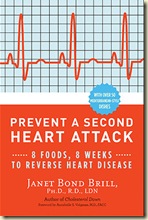
I have just finished reading Dr. Janet Bond Brill’s (PhD, RD, LDN) newest book, “Prevent a Second Heart Attack”. This book is packed full of useful information. Dr. Brill carefully explains the “How” and the “Why” the vessel damage occurs. More importantly, she thoroughly explains what you can do to prevent another cardiovascular episode. The book is full of tips for adopting a healthier diet. She includes a sample meal plan and over 50 delicious recipes to help you eat the Mediterranean way (“Dr. Janet’s Roasted Red Pepper Hummus” is superb and a new family favorite of ours!). The Mediterranean-style eating plan that Dr. Brill describes is a delicious, easy and cost-effective way to improve your health and prevent a second heart attack.
As Registered Dietitians and Certified Diabetes Educators working in the areas of public health, cardiac rehab, dialysis and long-term care, John & I routinely see the detrimental effects of poor dietary habits. This book will not only be useful to those who have had a heart attack, but to anyone who wants to adopt a healthier way of eating. It will be especially useful for anyone with Diabetes or Pre-Diabetes. Research has shown that people with Diabetes, even Pre-Diabetes, are much more likely to have a cardiac episode. In fact, the risk for having a second heart attack is twice as likely in someone who has diabetes. I am highly recommending this book to my clients, especially those who are living with Diabetes or Pre-Diabetes
This is not a “diet” plan. It is a delicious lifestyle that can easily be adopted and followed for life!
You can visit Dr. Janet Bond Brill’s book website at: http://preventasecondheartattack.com/
It’s Your Health. It’s Your Life. Make That Change!
~ Angie
????? ?? ??????Идея за подаръкикони
Permalink
March 1, 2011 at 5:40 am
· Filed under , Diabetes, General Nutrition & Wellness, Nutrition, Professional Interest, Wellness
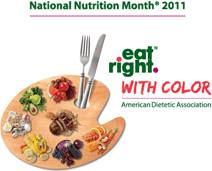 The weather is changing, the wind is blowing and some of our trees are staring to bloom. This is the time to break away from the winter blahs and start looking towards the Spring and a “rebirth” of life! March is celebrated as National Nutrition Month. This years theme is, “Eat Right with Color”. Increasing the number of colorful foods to your plates by adding more fruits and vegetables will help you to add more vitamins, minerals, anti-oxidants and phyto-chemicals to your diet. Research continues to show the benfits of eating more fruits and vegetables. From weight loss to better blood pressure control, to improved blood sugar levels, you can’t go wrong with fruits and vegetables! We encourage our clients to get at least 2-3 pieces of fresh fruit and 2-3 cups of vegetables everyday for better health. If that seems like more than you usually eat, start small and work your way up. Fresh or frozen, cooked or raw, frtuis and vegetables will provide you with more flavors, more nutrients and more protection! Eat from the natural rainbow of colors! Visit the American Dietetics Association site for more great tips on adding more colors to your plate! The weather is changing, the wind is blowing and some of our trees are staring to bloom. This is the time to break away from the winter blahs and start looking towards the Spring and a “rebirth” of life! March is celebrated as National Nutrition Month. This years theme is, “Eat Right with Color”. Increasing the number of colorful foods to your plates by adding more fruits and vegetables will help you to add more vitamins, minerals, anti-oxidants and phyto-chemicals to your diet. Research continues to show the benfits of eating more fruits and vegetables. From weight loss to better blood pressure control, to improved blood sugar levels, you can’t go wrong with fruits and vegetables! We encourage our clients to get at least 2-3 pieces of fresh fruit and 2-3 cups of vegetables everyday for better health. If that seems like more than you usually eat, start small and work your way up. Fresh or frozen, cooked or raw, frtuis and vegetables will provide you with more flavors, more nutrients and more protection! Eat from the natural rainbow of colors! Visit the American Dietetics Association site for more great tips on adding more colors to your plate!
It’s Your Health. It’s Your Life. Make That Change!
~John
Permalink
January 11, 2011 at 6:08 pm
· Filed under General Nutrition & Wellness, Professional Interest
One of my favorite segments on ESPN is the "C’Mon Man" spot. In this part of the Monday Night Football Pregame show, they review happenings from the weekend games of the weird, unexplainable, laughable and plays or actions that make no sense. While reading the paper on Sunday, I had my own Nutrition "C’Mon Man!" experience. The Parade Magazine for January 9th was headlining a question: "What is Your Health I.Q.?". With an apple on the front cover, I thought there may be some helpful health news on the inside. While the article did address some common health myths/questions such as does milk ca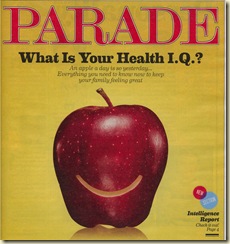 use an increase in mucus production (No) or can honey help a burn heal (Yes) and where is the most dangerous place to gain weight (Belly), that was not the issue. The problem I have with the publication are some of the other articles included. In this "health" issue, the recipe spotlight, Chicken Fried Steak! Providing you with close to 700 calories, 47 g of fat and 1,100 mg of sodium, this recipe plays into our nations health problems. C’MON Man! You’re going to tell me that after putting health information together you want to spotlight a high calorie, high fat, high sodium dish! At the same time, you’re also making it sound like eating an apple is not a smart way to go by stating “An apple a day is so yesterday”! Poor editing! You lose my respect! use an increase in mucus production (No) or can honey help a burn heal (Yes) and where is the most dangerous place to gain weight (Belly), that was not the issue. The problem I have with the publication are some of the other articles included. In this "health" issue, the recipe spotlight, Chicken Fried Steak! Providing you with close to 700 calories, 47 g of fat and 1,100 mg of sodium, this recipe plays into our nations health problems. C’MON Man! You’re going to tell me that after putting health information together you want to spotlight a high calorie, high fat, high sodium dish! At the same time, you’re also making it sound like eating an apple is not a smart way to go by stating “An apple a day is so yesterday”! Poor editing! You lose my respect!
Here’s my second nomination for the Nutrition C’MON Man!: I received an email urging my support for the Juvenile Diabetes Research Fund. How can you support this cause? You can buy a booklet of coupons valued at $15 for just a small donation of $5. Sounds like a bargain, right? But wait, the coupons are redeemable at Bojangles. Yep, that Bojangles where a PLAIN biscuit will give you 240 calories, 12 grams of fat, 3 grams of saturated fat and 663 mg of sodium! So who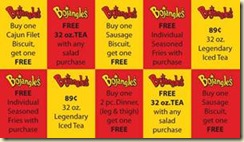 is promoting this deal? A hospital pediatrics unit! They’re excited too. They are offering a special deal: Buy their coupon book and you get to replace the free tea when you buy a salad with a buy one sweet potato pie get one free bargain! C’MON MAN!! Your actions must support your cause! While I support the cause, I will not support this program! is promoting this deal? A hospital pediatrics unit! They’re excited too. They are offering a special deal: Buy their coupon book and you get to replace the free tea when you buy a salad with a buy one sweet potato pie get one free bargain! C’MON MAN!! Your actions must support your cause! While I support the cause, I will not support this program!
These types of programs and promotions are part of the reason why so many people are confused when it comes to health choices. We continue to support the actions that are part of the cause for poor health. I refuse to give donations for "Relay for Life" teams selling barbeque plates and hot dog dinners. I will not support youth sports programs by selling doughnuts. We are not thinking outside the box. I know times are tight and all noble causes need funding to survive and promote their programs but at what cost do we do this? We are trying to take the easy way. How can we on one hand talk about the poor health of our nation yet on the other encourage the visitation of a fast food restaurant? There is a disconnect here that needs attention.
My final nomination for Nutrition C’MON MAN!: While visiting a hospital recently, I noticed a sign in the cafeteria stating: "New Year’s Resolution: Indulge!" Beneath the sign was a dessert and coffee table loaded with high calorie junk food. What kind of message is this sending? This promotion is occurring at the same time that the hospital is trying to encourage its teammates to sign a healthy living pledge to help reduce health care costs. C’MON MAN!! Does it make sense to promote indulgence in junk food while raising insurance deductibles? We must do better! It is unacceptable for a hospital to send this message.
Once again, I encourage you to take your health into your own hands! Exercise more, eat more meals at home, increase your intake of fruits and vegetables and don’t look for the easy button to better health. Make the commitment to yourself. To healthcare workers, I say, it is your responsibility to make sure your actions support your cause. Be the change you want to see in your clients. Make it happen!
It’s Your Health. It’s Your Life. Make that Change!
~John
Подаръци
Permalink
June 24, 2010 at 11:53 am
· Filed under General Nutrition & Wellness, Nutrition, Professional Interest
I spoke to the “Circle of Hope” mother’s group here in Elizabeth City this morning. I compiled a list of helpful resources for parents of young children and just wanted to share….
Nutrition Resources for Parents of Toddlers & Preschoolers
Books for Parents:

“Child of Mine: Feeding with Love and Good Sense”, Ellyn Satter MS, RD, LCSW, BCD. Bull Publishing Company; 3rd edition, 2000.

“Just Two More Bites!: Helping Picky Eaters Say Yes to Food”, Linda Piette, MS, RD. Three Rivers Press, 2006.

“Feed Your Family Right” by Elisa Zeid, MS, RD, CDN. Wiley, 2007.

“Baby Bites: Everything You Need to Know about Feeding Babies and Toddlers in One Handy Book” by Bridget Swinney, MS, RD. Meadowbrook, 2007.
Helpful Websites:
 http://www.dinnertogether.com http://www.dinnertogether.com
 My Pyramid: www.mypyramid.gov My Pyramid: www.mypyramid.gov
 Nutrition Pair, LLC: www.nutritionpair.com Nutrition Pair, LLC: www.nutritionpair.com   http://www.facebook.com/NutritionPair http://www.facebook.com/NutritionPair
Super Kids Nutrition: www.superkidsnutrition.com
Books for Children:
“Eating the Alphabet” by Lois Ehlert. HMH Books, 1996.
“Bread and Jam for Francis” by Russel Hoban. Harper Collins, 1964.
“Eat Your Peas” by Kes Gray & Nick Sharratt”. Harry N. Arams, Inc, 2006.
“The Carrot Seed” by Ruth Krauss. HarperCollins, 2004.
“I Will Never NOT EVER Eat a Tomato” by L. Child. Orchard Books, London, 2000.
“Muncha, Muncha, Muncha” by Candace Fleming. G. Brian Karas Atheneum Books for Young Readers, New York, 2002.
It’s Your Health. It’s Your Life. Make That Change!!!
~ Angie
Permalink
February 14, 2010 at 9:22 am
· Filed under Diabetes, General Nutrition & Wellness, Professional Interest
Happy Valentine’s Day! I wanted to take this day to discuss a subject that is near and dear to my heart. I am a Registered Dietitian and, yes, nutrition is a love of mine. However, I would have to say that my true passion lies in helping those who have diabetes live healthier and happier lives.
Chances are that you have a family member, friend or at least know of someone who has the diabetes. In the past 25 years, the rate of diabetes in the United States has more than tripled. Currently, 21 million, or seven percent of the U.S. population has this chronic disease (Source: NIDDK).
People who happen to have diabetes should not be called “diabetic”. In contrast, they should be referred to as “having diabetes”. It really makes me cringe when I hear an individual being identified as “the diabetic”. I hear it in both the lay as well as health care settings. It is especially displeasing when I hear it used in the medical community. Coming from a professional perspective, this is awful. People with diabetes are people. They are people who just happen to have diabetes.
It’s not about being politically correct. It’s about semantics. We need to consider the person. They are much more than their disease. As the wife of someone who has diabetes, it makes me even more upset. John is not a “diabetic”. John is a person — a wonderful person who lives a healthy, full life and has many different interests and hobbies. He just happens to have diabetes. John says it does not bother him to be called “diabetic”. “That’s what I am”, he will say. But, he does think it’s peculiar and amusing to call an object “diabetic” such as “diabetic yogurt”, “diabetic socks” or “diabetic shoes”. “The shoes don’t have diabetes”, he will say jokingly.
The term “diabetic diet” is even no longer used. The American Diabetes Association (ADA) eliminated the use of the terms “Diabetic Diet” and “ADA Diet” over ten years ago. They stated that there is no one diet for people with diabetes and that meal plans need to be individualized.
In that same sense, people with diabetes are individuals — individuals who happen to have diabetes. Please call them by their names and not a disease.
It’s Your Health. It’s Your Life. Make that change!
~ Angie
Permalink
August 28, 2009 at 12:20 pm
· Filed under General Nutrition & Wellness, Nutrition, Professional Interest
John and I are huge proponents of breastfeeding. As parents, we have seen the wonderful outcomes and rewards that breastfeeding has provided in our own children. As Registered Dietitians, we know that breastmilk is nature’s most perfect food. Besides the ideal balance of carbohydrate, protein, fat and micronutrients, it contains antibodies specifically obtained from the mother to destroy viruses and harmful bacteria. The benefits of breastmilk extend well into an infant’s adult years and will reduce their risk of ever developing obesity, diabetes or cancer.
August is World Breastfeeding Month and a time to “celebrate” breastfeeding. I participated in the University at Albany School of Public Health’s Breastfeeding Grand Rounds earlier this month. This year’s theme is “Breastfeeding: A Vital Emergency Response”. This is certainly an appropriate theme, especially as we are entering into peak hurricane season here on the east coast and the threat of upcoming H1N1 pandemic flu. What I will remember most from this webinar was the story told by a breastfeeding mother who was displaced during Hurricane Katrina. She spoke of how difficult it was for formula feeding mothers to find formula as well as uncontaminated water or supplies. Also, she spoke of the breastfeeding “heroes” that she witnessed–mothers who stepped in and fed the babies of mothers did not have formula or supplies.
With breastfeeding mothers, there are no worries about formula supplies, storage or contamination. The milk is readily available. Plus, breastmilk protects against diarrhea–which is a huge problem in disaster settings.
With the H1N1 threat, the Centers for Disease Control and Prevention (CDC) is stressing the importance of breastfeeding for protection against the H1N1 (swine) flu. The CDC states, “Flu can be very serious in young babies. Babies who are not breastfed get sick from infections like the flu more often and more severely than babies who are breastfed.” They are urging new mothers to initiate breastfeeding early (within the first hour of birth) and to feed frequently. Mothers who are breastfeeding should continue, even if they become ill. Formula should be avoided or minimized and breastfeeding maximized.
The Academy of Breastfeeding Medicine is also recommending for mothers to continue breastfeeding if they have the virus. If an infant is suspected to have H1N1, the infant should continue breastfeeding. They state, “Breastfeeding is generally beneficial in limiting the severity of respiratory infections in infants but information specific to this influenza is currently unavailable. During typical influenza outbreaks, often the infant has been exposed to the virus prior to the mother’s awareness that she has an infection. It is believed that the spread of this particular virus may occur 24 to 48 hours prior to the onset of symptoms. Exclusive breastfeeding up to 6 months of age provides optimal protection. The mother who is mixed-feeding (breastmilk plus other liquids or foods) may wish to attempt to increase the amount of breastmilk provided to her infant. If the infant has difficulty with direct breastfeeding, pumped or expressed milk can be provided.”
I know this from my personal experience nursing my daughter. Over Christmas 2003, John, Jonathan and I all contracted influenza. At the time, I was exclusivlely breastfeeding Bayleigh, who was two months old. I was so worried that she would get sick, but continued to nurse her throughout my illness. She stayed healthy and happy while the rest of us were bedbound for days!
Here in Elizabeth City, Jessica Williams, LPN & Certified Lactation Specialist, states: “the unique thing about breastmilk is that every component is used by the infant in some way. It’s the ultimate recipe for a new baby and a new mom. The immunity and vitamins and minerals provided just in the first few days after delivery alone by breastmilk are remarkable! Breastmilk was designed to nuture a baby just as a mother’s womb has the previous 9 months prior to being born”. Jessica teaches breastfeeding classes for expectant mothers and states that just educating moms about the wonderful components of breastmilk sometimes is all they need to get past the “fear of the unknown”.
Jill Overton is an Occupational Therapist and a new mother to a seven week old baby girl. Jill says, “I breastfed my son for a full year and feel that it contributed to him having little to no stomach or bowel upset, severe illness or allergies during that first year of his life. He was as healthy and as strong as could be!”. Breastfeeding is also calming to new mothers, “it allows me a wonderful opportunity to bond and snuggle with my baby during an otherwise chaotic day.”
I think this quote from James Grant, the Executive Director for Unicef from 1980-1995 sums it all up: “Imagine that the World had created a new ‘dream product’ to feed and immunize everyone born on earth. Imagine also that it was available everywhere, required no storage or delivery and helped mothers to plan their families and reduce the risk of cancer. Then imagine that the world refused to use it”.
It’s Your Life. It’s Your Health. Make That Change!
~ Angie
Permalink
April 22, 2009 at 4:51 am
· Filed under Diabetes, Professional Interest
I was lucky enough to be invited to attend the Johnson & Johnson Diabetes Institute in Milpitas, California at the beginning of April. The Institute is a 2 day intensive diabetes education/training session to help Diabetes Educators, Nurse Practitioners, Physician Assistants, & other Health care providers find innovative answers to to some of the challenges facing diabetes care. Topics ranged from Insulin Pump Therapy to Continuous Glucose Management to Reimbursement issues to Behavioral Change Techniques. Overall, the session was very enlightening for me. I was able to meet with Diabetes Educators from around the United States and share ideas on improving diabetes care.
One session I really enjoyed involved the topic of diabetes medications. With Type 2 Diabetes, the patient is usually diagnosed some time after diabetes has developed. Treatment is normally started with oral medications (pills) along with lifestyle & diet change. Insulin is usually a last-ditch effort to improve blood sugar control. However, Type 2 Diabetes is a progressive disease. When Type 2 is diagnosed, many years may have passed since the patient truly developed the disease. In that time, the pancreas may have already maxed out its insulin production. What that means is that insulin may be needed sooner than would be expected. What that also means is that insulin starts should not be seen as patient “failures”. The nature of Type 2 Diabetes progression will eventually lead to that, regardless of overall control. Therefore, it is important to at least start talking about insulin use soon after the diagnosis is made. There is no question that initiating insulin brings up many fears in patients and providers alike. But if you look at the types of insulin that are available today, we have significantly more choices and options than we did just 10 or 15 years ago.
Insulin is a medication that could be considered much more natural than its oral counterparts. Insulin is simply a hormone made by the pancreas to help the body utilize energy. With insulin, you may run a higher risk of having hypoglycemic (low blood sugar) episodes but those can be minimized. In fact, some oral agents are contraindicated in geriatric patients or those with kidney, liver or heart disease. There is less risk to the liver and kidneys with insulin as it is not excreted through these organs like many of the oral agents. A major benefit to using insulin is that it allows you to tailor your approach to blood sugar control. It gives you the opportunity to fine tune adjustments and get exactly what you need, when you need it. Of course, when using insulin you must still balance between exercise and proper food intake to get the maximum benefit!
We need to make sure that we don’t view the use of insulin as a failure. Insulin should be used more freely as a means to achieving better blood glucose control earlier on in the treatment of diabetes. Once on insulin, we would encourage more frequent blood glucose testing. This gives the patient instant feedback on how his or her therapy is progressing. We have multiple tools available to us. We must use them more efficiently.
If you are not meeeting your diabetes health related goals, talk to your physician about the possible use of insulin. There are risks and benefits associated with any medication change, but if it enables you to control diabetes better, the benefits will far outweigh the risks. Take control of your diabetes!
It’s Your Health! It’s Yor Life! Make That Change!
Johnикони
Permalink
« Previous Page — � Previous entries « Previous Page · Next Page » Next entries � — Next Page »
|
 |
|
|
 “Imagine that the World had created a new ‘dream product’ to feed and immunize everyone born on earth. Imagine also that it was available everywhere, required no storage or delivery and helped mothers to plan their families and reduce the risk of cancer. Then imagine that the world refused to use it”. — James Grant, Executive Director for Unicef (1980-1995).
“Imagine that the World had created a new ‘dream product’ to feed and immunize everyone born on earth. Imagine also that it was available everywhere, required no storage or delivery and helped mothers to plan their families and reduce the risk of cancer. Then imagine that the world refused to use it”. — James Grant, Executive Director for Unicef (1980-1995).















